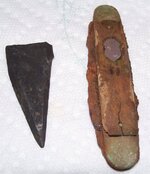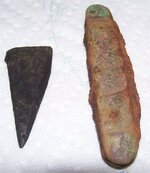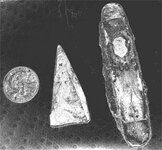I'm new by the way, but my dad has been on here for quite some time, I just can't remember his name. 
I found this Arrowhead looking object buried in sand at a lake that has been receding this past year or so. The approx. size of the water falling back is said to be the size of a football field. It was about 4 inches down, way out near where the water level is currently.
It smells sort of like sulfur & came out of the ground with a charcoal-like residue on it, but so did most other things me and my dad found.
We figured it might just be a spike used to tether a buoy down for swimmers, but it's just so far out there. It could have been those buoys you see out in the middle of lakes, too, but who knows..
On the detector (Ace 250) it reads hard iron, with the occasional nickel ding. Under the ground it read like a dime or quarter, I forget which one.
I will release the name of the lake, because the area required a permit to be detected.
White Bear Lake got its name from a Sioux Indian legend about a Sioux hunter who killed a white bear on Manitou Island and whose spirit lives on Manitou Island still. Manitou Days is a celebration in honor of the white bear’s spirit.
Nine Indian mounds were located on the Northwest shores of the lake.
I added the pocket knife & quarter to show relative size. The knife was found at an old school, nowhere near White Bear Lake.


I found this Arrowhead looking object buried in sand at a lake that has been receding this past year or so. The approx. size of the water falling back is said to be the size of a football field. It was about 4 inches down, way out near where the water level is currently.
It smells sort of like sulfur & came out of the ground with a charcoal-like residue on it, but so did most other things me and my dad found.
We figured it might just be a spike used to tether a buoy down for swimmers, but it's just so far out there. It could have been those buoys you see out in the middle of lakes, too, but who knows..

On the detector (Ace 250) it reads hard iron, with the occasional nickel ding. Under the ground it read like a dime or quarter, I forget which one.
I will release the name of the lake, because the area required a permit to be detected.
White Bear Lake got its name from a Sioux Indian legend about a Sioux hunter who killed a white bear on Manitou Island and whose spirit lives on Manitou Island still. Manitou Days is a celebration in honor of the white bear’s spirit.
Nine Indian mounds were located on the Northwest shores of the lake.
I added the pocket knife & quarter to show relative size. The knife was found at an old school, nowhere near White Bear Lake.










